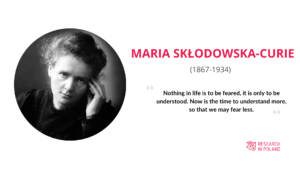Ninety years ago, on 4 July 1934, Marie Skłodowska-Curie, the only woman to receive the Nobel Prize twice, died at the age of just 67 from malignant anaemia. Her life – as she wrote in her memoirs – was not easy.
Born Maria Skłodowska on 7 November 1867 in Warsaw, Poland, she was the youngest of five children of poor school teachers. After her mother died and her father could no longer support her she became a governess, reading and studying in her own time to quench her thirst for knowledge. She never lost this passion.
During the later 1800s, universities rarely admitted women—most of them forbade it. This led Curie to enrol at the Flying University in Warsaw. A patriotic institution, it shunned the ideology of the Russian Empire, which Poland was then part of, by teaching students traditional Polish scholarship.
In 1891, she went to Paris and start her studies at the Sorbonne where she obtained Licenciateships in Physics and the Mathematical Sciences. She met Pierre Curie, Professor in the School of Physics in 1894 and in the following year they were married.
Her early researches, together with her husband Pierre Curie, were often performed under difficult conditions, laboratory arrangements were poor and both had to undertake much teaching to earn a livelihood. The discovery of radioactivity by Henri Becquerel in 1896 inspired the Curies in their brilliant researches and analyses which led to the isolation of polonium, named after the country of Marie’s birth, and radium. Curie developed methods for the separation of radium from radioactive residues in sufficient quantities to allow for its characterization and the careful study of its properties, therapeutic properties in particular.
Together with her husband, she was awarded half of the Nobel Prize for Physics in 1903. After becoming the first woman to be granted a Nobel Prize, Curie later became the first person to earn a second one.
Following her husband’s tragic death in a 1906 accident, Marie was appointed to Pierre’s seat at the Sorbonne, making her the university’s first female professor. Just three years earlier, she had been the first woman in France to earn a doctorate. In 1911 she received a second Nobel Prize, this time in Chemistry, in recognition of her work in radioactivity.
On the eve of the First World War, Curie was a world-famous scientist. In 1914, she became head of the new Radium Institute at the Sorbonne, which developed into one of the world’s leading centres for nuclear physics. During the world war, Curie developed a mobile X-ray station together with Irène. She obtained a driving licence and personally drove the car to the front to examine injured soldiers on site. On her initiative, around 200 radiology centres were gradually established during the war.
On 4 July 1934, at the Sancellemoz Sanatorium in Passy, France at the age of 66, Marie Curie died. The cause of her death was given as aplastic pernicious anaemia, a condition she developed after years of exposure to radiation through her work.
In 1995 the remains of Curie and her husband were enshrined in the Panthéon in Paris, a mausoleum reserved for distinguished French thinkers. She became the second woman to receive this honour and the first to earn it through her own achievements.

Source:
https://www.mariecurie.org.uk/who/our-history/marie-curie-the-scientist


